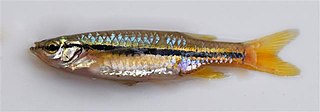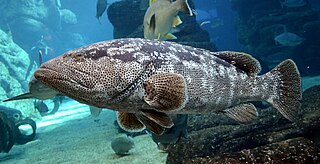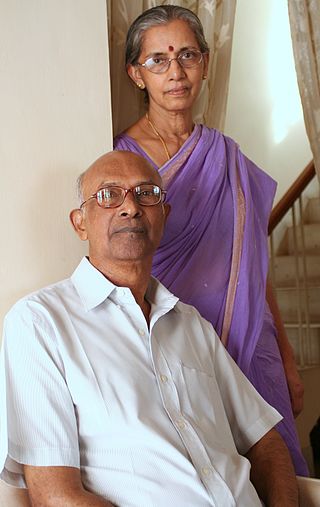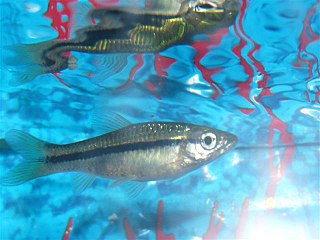
The yellow-wattled lapwing is a lapwing that is endemic to the Indian Subcontinent. It is found mainly on the dry plains of peninsular India and has a sharp call and is capable of fast flight. Although they do not migrate, they are known to make seasonal movements in response to rains. They are dull grey brown with a black cap, yellow legs and a triangular wattle at the base of the beak. Like other lapwings and plovers, they are ground birds and their nest is a mere collection of tiny pebbles within which their well camouflaged eggs are laid. The chicks are nidifugous, leaving the nest shortly after hatching and following their parents to forage for food.

Esomus, or flying barbs, are freshwater fish native to South and Mainland Southeast Asia. They are closely related to the genus Danio and are distinctive for their extremely long barbels.

The Indian flying barb, historically flying barb, is one of the species known in the group flying barbs owing to their extremely long barbels. It was discovered as long ago as 1822 by Hamilton. However, it is rarely seen in aquaria. It is found in Myanmar, Nepal, Pakistan, Sri Lanka and India, it is found in many of the same localities as Danio rerio and Danio dangila, an example being the Jorai Rivulet, a tributary of the Sankosh river in Coochbehar district, West Bengal, India. The rare fish Borellius spp. is locally named "Boirali maach".

The Malabar grouper also known as blackspot rockcod, estuary rockcod, giant rock cod, greasy grouper, Malabar rockcod, Morgan's cod or speckled grouper, is a species of marine ray-finned fish, a grouper from the subfamily Epinephelinae which is part of the family Serranidae, which also includes the anthias and sea basses. It is found in the Indo-Pacific region. It has entered the Mediterranean Sea from the Red Sea by way of the Suez Canal as a Lessepsian migrant.

Hortus Malabaricus is a 17th-century botanical treatise on the medicinal properties of flora of the Malabar coast. It was compiled by Hendrik van Rheede, the Governor of Dutch Malabar from 1669 to 1676. Itty Achudan, a distinguished herbalist from the ancient traditional Ezhava physicians of Kerala, was Van Rheede's key informant who disclosed the Ayurvedic traditional knowledge about the plants of Malabar to him. Hortus Malabaricus was published posthumously in Amsterdam between 1678 and 1693. English and Malayalam translations of Hortus Malabaricus were published by University of Kerala in 2003 and 2008 respectively, which was largely due to the efforts of Professor K. S. Manilal, an Emeritus of the University of Calicut who devoted over 35 years of his life to research for the translation and annotation work of the original text of Hortus Malabaricus in Latin.

Itty Achudan , known to have lived during the second half of the 17th century, was a distinguished herbalist, belonging to an Ezhava family of physicians in Kerala who practised pre-Ayurvedic systems of traditional medicine. The Kollatt family are natives of Kadakkarappally, a coastal village, north-west of Cherthala town, in Kerala, South India. Itty Achudan was the most remarkable Indian figure associated with Hortus Malabaricus, the botanical treatise on the medicinal properties of flora in Malabar, in the 17th-century. It was compiled by the Dutch Governor of Malabar, Hendrik van Rheede, and Itty Achudan was Van Rheede's key informant who disclosed the pre-Ayurvedic traditional knowledge about the plants of Malabar to him. Hortus Malabaricus was published posthumously in Amsterdam between 1678 and 1693. The preface to Hortus Malabaricus includes a mentioning about Itty Achudan and a testimony revealing his contribution in his own hand writing. Itty Achudan was introduced to Van Rheede by Veera Kerala Varma, the then ruler of the erstwhile state of Kochi.

Kattungal Subramaniam Manilal is an Emeritus of the University of Calicut, a botany scholar and taxonomist, who devoted over 35 years of his life to research, translation and annotation work of the Latin botanical treatise Hortus Malabaricus. This epic effort brought to light the main contents of the book, a wealth of botanical information on Malabar that had largely remained inaccessible to English-speaking scholars, because the entire text was in the Latin language.

The danionins are a group of small, minnow-type fish belonging to the family Cyprinidae. Members of this group are mostly in the genera Danio, Devario, and Rasbora. They are primarily native to the fresh waters of South and Southeast Asia, with fewer species in Africa. Many species are brightly coloured and are available as aquarium fish worldwide. Danio species tend to have horizontal stripes, rows of spots, or vertical bars, and often have long barbels. Devario species tend to have vertical or horizontal bars, and short, rudimentary barbels, if present at all. All danionins are egg scatterers, and breed in the rainy season in the wild. They are carnivores, living on insects and small crustaceans.

Esomus metallicus, sometimes known as striped flying barb, is a species of cyprinid found in Southeast Asia, including the Salween, Mekong, and Chao Phraya river systems. It is found in fresh and brackish water. It grows to 7.5 cm (3.0 in) standard length.

Esomus thermoicos is a species of barb in the family Cyprinidae. It is found in freshwater streams, ponds and rivers of southern India and Sri Lanka. It is threatened by habitat loss. It is sometimes considered conspecific with the South Indian flying barb.

Lutjanus malabaricus, the Malabar blood snapper, saddletail snapper, large-mouthed nannygai, large-mouthed sea-perch, Malabar snapper, nannygai, red bass, red bream, red emperor, red Jew, red snapper, saddletail seaperch, scarlet emperor or scarlet sea-perch, is a species of marine ray-finned fish, a snapper belonging to the family Lutjanidae. It is native to the Indian Ocean and the western Pacific, where it is found east to Fiji and Japan.

The Burmese flying barb is a species of cyprinid fish endemic to Myanmar.

Esomus altus is a species of cyprinid endemic to Myanmar.

The South Indian flying barb is a species of cyprinid endemic to India where it is found in drainages in the Eastern Ghats and Western Ghats. It is sometimes considered conspecific with Esomus thermoicos.
The striped flying barb is a species of cyprinid. It is found in Bangladesh, India, and Sri Lanka. Esomus metallicus is also sometimes known as the striped flying barb.
The Mekong flying barb is a species of cyprinid found in Mekong river basins in Thailand, Laos, Cambodia and Viet Nam.
The Malayan flying barb is a species of cyprinid found in Malaysia and Vietnam.
Esomus manipurensis is a species of cyprinid endemic to drainages in Manipur in India.













